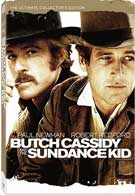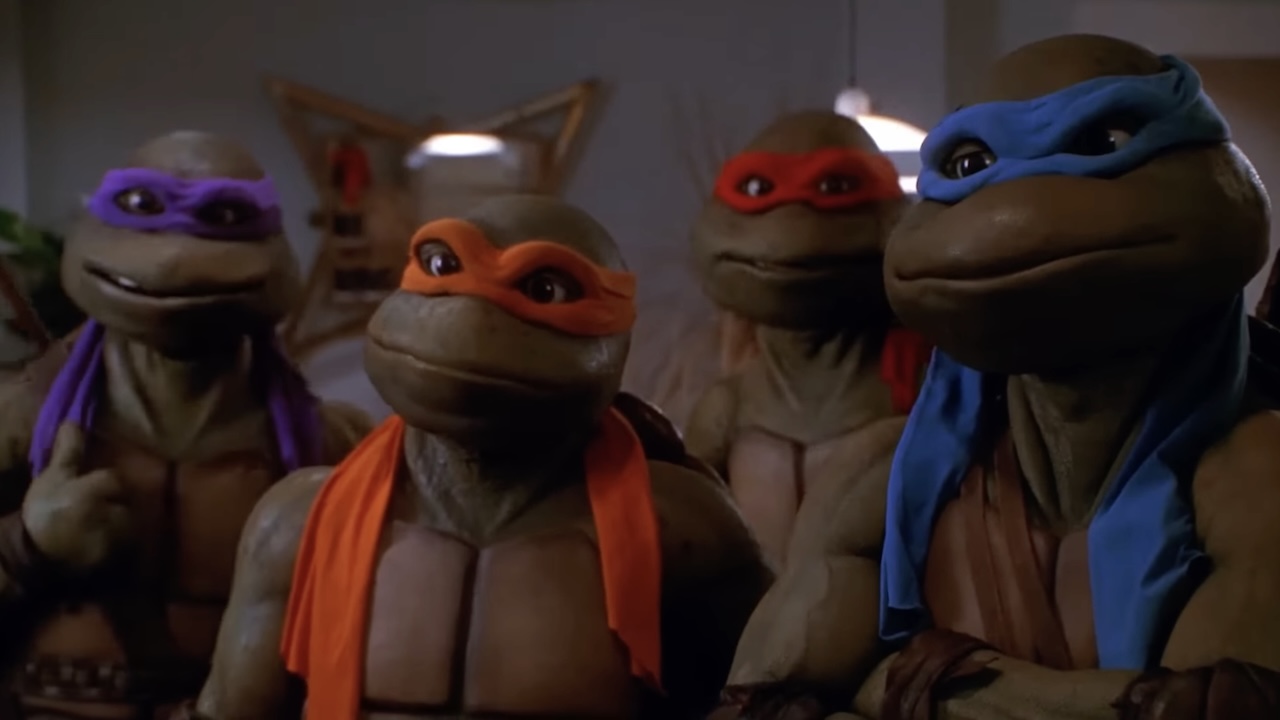“John Wayne don’t run.” When screenwriter William Goldman was shopping his script for the movie The Sundance Kid and Butch Cassidy, he got a lot of offers, but one studio head said he wouldn’t buy the script unless Goldman changed the plot to have the title characters stand and fight their pursuers rather than running to Bolivia. Goldman explained that the script was based on fact and that the two outlaws did indeed run, to which the studio head replied with the above quote. That pretty much sums up everything that works about what was eventually renamed Butch Cassidy and the Sundance Kid, the 1969 classic (out now in a brand new 2 Disc Collector’s Edition) that went on to win an armful of Academy Awards, make Robert Redford a star, reinvent the Western, and originate the “buddy picture.” John Wayne never ran, but Butch and Sundance run like hell. The plot of Butch Cassidy and the Sundance Kid is pretty well known, but if you’ve never seen it: Butch Cassidy (Paul Newman) is the leader of the Hole-in-the-Wall Gang, train and bank robbers in 1890’s Utah. Cassidy is the brains of the group, leaving the crack shooting to his partner, the Sundance Kid (Robert Redford.) In addition to leading their band of somewhat dim associates, the two banter like a pair of old women. This is the basis for much of the humor in the film, and the comic timing of Newman (who didn’t have confidence in his comic abilities and was worried about playing Cassidy for just that reason) and Redford is impeccable.
The use of humor in a Western was not new in 1969, but typically was limited to someone like Don Knotts or Bob Hope playing a buffoon who moves through a series of farcical situations and survives on dumb luck. As is demonstrated time and again, Butch and Sundance are not buffoons or even comics, they are just likeable guys who happen to steal stuff. While this sort of action-buddy banter is familiar and common these days, it pretty much originated with this film. Most of the classic lines from the movie are based in the close relationship between the leads and their ability to criticize or mock each other at almost any time. While attempting to open up a safe, Cassidy blows up the entire railroad car the safe is in and nearly kills himself and Sundance. With cash, smoke, and wood drifting down around them Redford looks at Butch and dryly asks, “Think you used enough dynamite there, Butch?”
While the two would be happy to enjoy this way of life forever, the future pushes them out of their comfortable life and on the run. A Super Posse begins to chase Butch and Sundance after a railroad magnate tires of their constantly robbing his trains. Director George Roy Hill shoots them from a distance, a faceless, relentless entity that spells the end of life as previously known in the West. Butch and Sundance, previously good natured, humorous scamps, begin to demonstrate ever increasing panic as they are unable to shake the posse. Man, despite all his talents, sometimes comes into contact with a force over which he has no control; in this case, the future. Butch and Sundance’s time has passed, they just don’t know it yet.
The run from the posse gives Cinematographer Conrad Hall a chance to work his magic in the beautiful areas around Utah and Mexico. He justifiably won an Oscar for his work (as did the script and the music.) Butch and Sundance eventually make their way to Bolivia with Sundance’s girlfriend, Etta (Katherine Ross) and attempt to go straight. But the future is coming, and, as one character puts it, for a pair of “two-bit outlaws on the dodge,” it’s pretty much over. I haven’t seen any previous versions of this movie on DVD (I own a well played VHS copy that I’m happily upgrading for this Collector’s Edition DVD), so I can’t comment on if it is worth buying this version as an upgrade. There is a one-disc Special Edition from 2000 which has one commentary, a making-of featurette, interviews with the cast and screenwriter, and some DVD-Rom info on the real outlaws. I can say, without reservation, that if you only own VHS or no version, picking this up at $16-$20 is an excellent value. The film is shown in anamorphic widescreen (2.35 to 1) which shows off the amazing cinematography well. The sound is Dolby 5.1 and you have no trouble picking up the dialogue, even when Redford mumbles, which he sometimes does. Not only is the movie a classic, but there is a nice selection of extras. There is a bit of padding, which drops the rating a bit, but you get a good value with the 2 disc set. Here is what you get:
“Commentary by Director George Roy Hill, Cinematographer Conrad Hall, Lyricist Hal David, and Documentary Filmmaker Robert Crawford, Jr.” – This commentary was recorded for the 2000 SE DVD and is re-used here. Hill was clearly nearing the end of his life (he died in 2002) and barely participates. When he does, he is obviously reading from a script and it’s unlikely he was even watching the movie at the time. Hal David shows up only briefly during the “Raindrops Keep Fallin’ on My Head” scene. So it is Hall and Crawford who give most of the commentary and they are actually pretty good. They don’t seem to be in the same room but each has insights and interesting facts about the shots. Crawford is meant to be a stand-in for Hill and often starts his comments with “George wanted…” or “What George was doing here was…..” Certainly of interest to any fan of the film.
“Commentary by Screenwriter William Goldman” - Wow, what a disappointment. Most of the comments Goldman makes about the writing process and casting are also repeated in the interviews or features included in this set, so they are available elsewhere. His direct comments about the movie as he watches are along the lines “I just love this scene” or “Redford and Newman do such a great job here, I love what they did” or “I love the cinematography of this ride.” There are also four to five minutes where he says nothing at all, you almost forget (as Goldman apparently did) that you are listening to a commentary track. He does make a few critical comments about people who work at studios and movies today that are interesting, but not so interesting you want to listen to to the whole thing again. Recorded recently since he refers to March of the Penguins at one point, but you aren’t missing anything by skipping this altogether.
“1994 Documentary: The Making of Butch Cassidy and the Sundance Kid” – A very oddly titled extra. Despite how it is titled on the disc, this documentary was actually made in 1968 as they were shooting the picture. This is the only extra in this package that shows "behind the scenes" during the shoot. Directed by Production Assistant Robert Crawford, Jr. (who also does one of the commentaries to the film), George Roy Hill narrates most of it and explains how many of the shots (like the jump off the cliff) were done. Also, since this was completed prior to the release of the movie, Hill had no idea how the film would be received. He even comments on how he hopes the audience accepts the picture when it is released. The extra most likely to be of interest to film buffs and the only extra (besides the two commentaries) found on Disc 1.
Your Daily Blend of Entertainment News
“All That Follows is True: The Making of Butch Cassidy and the Sundance Kid” - A new featurette about 35 minutes long. It focuses on the making of the movie with interviews with all the principals who are still around (basically everyone but George Roy Hill.) A discussion of how the script was sold, the casting process (Jack Lemon as Butch, Paul Newman as Sundance!), the making of the movie, and the original reaction (not so good, at least from critics.) Pretty much a typical DVD “making of” segment, somewhat hampered by the length of time between the actual events and the interviews and the lack of any behind-the-scenes film.
“The Wild Bunch: The True Tale of Butch & Sundance” - A 25 minute new featurette on how much of the movie is actually true. Some Butch Cassidy (the man, not the movie) experts discuss scenes from the movie and how they compare to the truth (or at least what historians think actually happened.) Most of the scenes fall under the category of being based somewhat in fact or an actual event but having been adjusted for the movie.
“1994 Interviews” - The title pretty much says it all. Apparently shot for the 25th anniversary of the movie but I don’t know if they were used for a VHS release or what. Newman, Redford, Goldman, and Ross are interviewed for about 10 minutes about their experience and remembrance. Composer Burt Bacharach’s interview lasts about 2 minutes and says very little. There is a brief section called “Maybe Some of What Follows is True,” where contradictory statements by the interviewees are spliced together so one person makes a statement about the filming and then the next person denies it is true. It’s entertaining, but short.
“History Through the Lens: Butch Cassidy and the Sundance Kid: Outlaws Out of Time” - This is a 90 minute documentary from 2000 narrated by Burt Reynolds of all people. Not truly focused on the movie other than as a jumping off point for historians and others to talk about the true exploits of Butch and Sundance. This covers a lot of the same ground as “The Wild Bunch” featurette, but is a little more in-depth. It was clearly made to be shown on television, as there is the usual fade to black every 10 to 15 minutes or so.
“Deleted Scene” - One three minute scene showing Butch, Sundance, and Etta in Bolivia watching a movie of their exploits. The dialogue track was lost so there are subtitles. Director Hill has an optional commentary where he explains why they shot the scene in the first place and why they dropped it.
“The Films of Paul Newman” - Uhhhhh…..yeah. This is just a collection of eight trailers of Paul Newman movies. They don’t seem to have any rhyme or reason until you realize they are all Fox Studio movies. The worst kind of padding, but some of the trailers are pretty funny.
“Production Notes” - These are still pictures of letters sent primarily from the producer and studio to the director and others about the budget and requests to make changes in the script or picture. Pretty interesting, but they couldn’t get entire document pages on one screen so it makes the process of reading an entire document a little laborious. My favorite recommendation was the request to add more sex to the movie, perhaps in Bolivia.
“Alternate Credits Roll” - I can never have too many versions of the end credits of a movie, can you?
“Theatrical Trailers” - This is just what it sounds like, three trailers shown in the theaters at the movie’s original release. One is three minute and the other two are a minute each. It’s interesting to see how trailers were made in the late 1960’s, which is also the one redeeming feature of the Paul Newman Trailers mentioned earlier.

